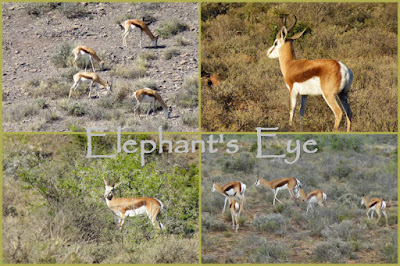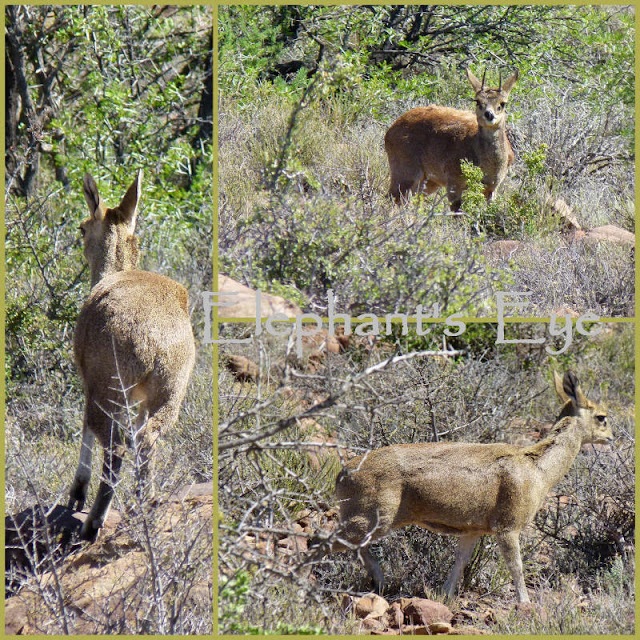With leaf ears in Gondwana
By Diana Studer
- gardening for biodiversity
in Cape Town, South Africa
These are the Karoo animals which had to adjust to a new
world which contains lions,
who see them as Lunch.
Easy to identify. Head turned to gaze at you. The large ears spread so you can see the leaf pattern made by the 'veins'.
‘Until a century ago the Karoo witnessed the largest wildlife migrations known to modern man. In 1849 there was a trek that took three whole days to pass thru Beaufort West. In 1896 one trek covered 220 by 25 km. A few million animals, mostly springbok, but also eland, quagga (now extinct), black wildebeest and red hartebeest. First recorded by naturalists in the late 18th C as occurring about every 10 years. Treks were triggered by springbok population explosions in the Northern Cape interior with its summer rainfall. The animals moved to the West Coast and the Southern Karoo where we have winter rainfall. Sometimes the journey ended with tens of kilometres of drowned springbok on the Atlantic shore. In the late 19th C hunters after biltong and hides killed over 1,000 animals a day. Then the Anglo-Boer War took its toll. And the migrations were no more.’ From the museum in the Karoo National Park.
The gemsbok or Cape Oryx has 122cm LONG horns, on which it
will skewer lions.
Most of the animals we saw were red hartebeest with their
heavy horns.
The kudu with its gracefully furled horns. Pairs of bulls
have been found dead, with their horns interlocked - MainlyMongoose
The strangest animal we saw, with a donkey-like head. These
are female reedbuck.
Three times we drove around Lammertjiesleegte and each time
we saw this little black-backed jackal. At lions kills they will wait for
leftovers. Early in the morning, he is watching the new world rising.
Forty years ago I came on a geology field trip to the Karoo.
These Cape Fold Belt Mountains, stretching from where I was born between Table
Mountain and the Twelve Apostles, to the Groot Winterhoek, and the Karoo, are a
reminder of Gondwana.
In the mists of time Africa, South America, India and Australia were one vast
continent. An ancient volcano with dolerite dykes and sills, eroded away over
time. Dolerite sills remain making flat-topped mountains with cliffs.
A stitch in time. The sea gathers mud into ripples. The
earth sets those ripples in stone, and so they remain until eroded. The teeth
belonged to a mega-herbivore in the Permian Period called Bradysaurus. In
a fossilised tree trunk you can see the growth rings.
Most visitors stay in this park just overnight, breaking the
journey stretching north all the way from Cape Town to the Zimbabwean border.
In the park only this road, up the Klipspringer Pass was tarred in November
2010. The dirt roads are marked for 4x4, or not.
Klipspringer Pass is named for these small buck.
‘Silhouetted, seemingly on tiptoe, on a high rock against the sky. Our only antelope, capable of bounding over precipitous rockfaces, balancing on incredibly small surfaces. This neat and robust little creature walks on the front edges of its hooves. The [klipspringer] coat is bouncy to provide protection against sharp edges in his mountain habitat.’
In this hot and dry place, you don't expect Karoo violets!
Info on buck from Paul Rose - The Wildlife of South Africa
I invite you to join us at Elephant's Eye on False Bay. Please subscribe as you prefer
Via Feedly,
Or Bloglovin,
Email with Feedburner,
Or Facebook
Pictures by Jurg Studer
of Elephant's Eye on False Bay
(If you mouse over teal blue text, it turns seaweed red.
Those are my links.
To read or leave comments, either click the word Comments below,
or click this post's title)
I invite you to join us at Elephant's Eye on False Bay. Please subscribe as you prefer
Via Feedly,
Or Bloglovin,
Email with Feedburner,
Or Facebook
Pictures by Jurg Studer
of Elephant's Eye on False Bay
(If you mouse over teal blue text, it turns seaweed red.
Those are my links.
To read or leave comments, either click the word Comments below,
or click this post's title)












Oh, fabulous pictures. Those Bradysaurus teeth!!
ReplyDeleteAs for the big ears.. all the better to hear the lions with.
Thanks for this beautiful view of the amazing wildlife near you. I never realized the Steenbok had leaf-shaped ears--delightful! The view on Klipspringer Pass is beautiful!
ReplyDeleteWhat wonderful photos of this very beautiful and interesting part of our world you live in. Thank you for sharing.
ReplyDeleteFlowerLady
How wonderful to have access to these beautiful wild creatures! We have very few wild creatures left in the southern California, where one city blends into another. (I don't count the coyotes and the raccoons who've adapted, in their way, to living with humans.) The mountain lions and brown bears are treated almost as celebrities, with sightings reported in the newspaper.
ReplyDeleteOur urban caracal researcher comes to us from California's mountain lions.
Deletehttp://www.urbancaracal.org/people-and-contact/
Another fascinating posting, Diana. The wildlife migration you describe reminds me of the mass human migration from New York and Philadelphia to our area of the Pocono Mountains which lies within 100 miles of those two cities. My husband's chief complaint is the destruction of wildlife habitat, as he observes the many changes since he was a lad. Your jackal looked like our fox at first glance, but I think the jackal is much bigger. P. x
ReplyDeletethe jackal is sturdier, not as slender and graceful as a fox.
DeleteThanks for sharing the beautiful place that you live in and know so well; the trek must have been an amazing thing to see, or perhaps even a little scary but sad that it is no more.
ReplyDeleteWhat beautiful animals! How very sad the migrations are no more. Such a loss. That would have been an amazing site to see, with the land filled with animals.
ReplyDeletemakes me think of Martha - the last passenger pigeon.
DeleteHi Diana,
ReplyDeleteLove your blog. It reminds me of my childhood years in Cape Town. This posting of the Klein Karoo especially so, as my dad and I spent many days driving through the area enjoying its magic 30 years ago. Now living in Texas I do my own native/wildlife gardening here. Also thanks for writing some german too, since I have to practice my childhood language from time to time to keep up. Here's my gardening blog in Texas if you're interested. http://sun-dancing.net/blog/
This one is the Great Karoo.
DeleteBut I've also blgged about the Klein Karoo
http://eefalsebay.blogspot.co.za/2015/07/where-aloes-live-on-karoo-koppie.html
I was struck by the similarities between many of your animals and many of ours. I wonder if these had common ancestors back before South America and Africa separated and drifted apart across the ocean. -Jean
ReplyDeleteI'd never thought about Steenbok ears as Leaves before. But very apt. KNP: I love that place.
ReplyDeleteThe Cape Oryx are particularly lovely, but how sad that the huge migrations are no more. Your landscapes are steeped in history and being able to see the past imprinted like those tooth marks is very special.
ReplyDeleteI don't understand why the journey sometimes ended with tens of kilometres of drowned springbok on the Atlantic shore. Were they trying to swim across like lemmings?
ReplyDeleteperhaps in years when there were simply so many animals, and the grazing ended at the sea?
DeleteAmazing images! Hot, dry, and beautiful. I have always been fascinated by fossils, our connection to ancient times.
ReplyDeletethose ripples, time frozen. Wish we had such a rock outcrop in our garden!
Deletewhat an amazing place to live, I would love to visit this place one day,, it is just so alive in every way, so much history, one could never be bored with so much richness about you,,
ReplyDelete
ReplyDeleteWhat an amazing place! I must read it a few more times to take in all the new information. I can recognise a springbok but all the other reasonably similar animals are uniquely wonderful. I especially like the one with the leafy ears - and the little one, and the one that looks like a donkey...
The fossils are also fascinating - and what images the word Gondwanaland always conjures up.
Thanks for sharing :)
You have the most fascinating and beautiful animals...each horned critter was more unusual....and all those fossils tell such a interesting tale of the land there.
ReplyDelete